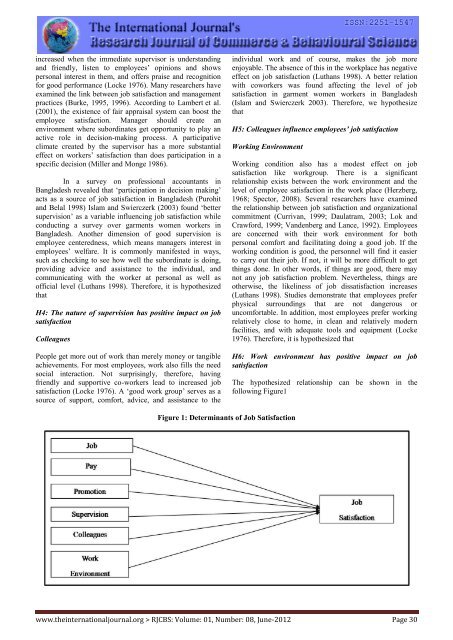Research Journal of Commerce & Behavioural Science - RJCBS
Research Journal of Commerce & Behavioural Science - RJCBS
Research Journal of Commerce & Behavioural Science - RJCBS
Create successful ePaper yourself
Turn your PDF publications into a flip-book with our unique Google optimized e-Paper software.
increased when the immediate supervisor is understanding<br />
and friendly, listen to employees’ opinions and shows<br />
personal interest in them, and <strong>of</strong>fers praise and recognition<br />
for good performance (Locke 1976). Many researchers have<br />
examined the link between job satisfaction and management<br />
practices (Burke, 1995, 1996). According to Lambert et al.<br />
(2001), the existence <strong>of</strong> fair appraisal system can boost the<br />
employee satisfaction. Manager should create an<br />
environment where subordinates get opportunity to play an<br />
active role in decision-making process. A participative<br />
climate created by the supervisor has a more substantial<br />
effect on workers’ satisfaction than does participation in a<br />
specific decision (Miller and Monge 1986).<br />
In a survey on pr<strong>of</strong>essional accountants in<br />
Bangladesh revealed that ‘participation in decision making’<br />
acts as a source <strong>of</strong> job satisfaction in Bangladesh (Purohit<br />
and Belal 1998) Islam and Swierczerk (2003) found ‘better<br />
supervision’ as a variable influencing job satisfaction while<br />
conducting a survey over garments women workers in<br />
Bangladesh. Another dimension <strong>of</strong> good supervision is<br />
employee centeredness, which means managers interest in<br />
employees’ welfare. It is commonly manifested in ways,<br />
such as checking to see how well the subordinate is doing,<br />
providing advice and assistance to the individual, and<br />
communicating with the worker at personal as well as<br />
<strong>of</strong>ficial level (Luthans 1998). Therefore, it is hypothesized<br />
that<br />
H4: The nature <strong>of</strong> supervision has positive impact on job<br />
satisfaction<br />
Colleagues<br />
People get more out <strong>of</strong> work than merely money or tangible<br />
achievements. For most employees, work also fills the need<br />
social interaction. Not surprisingly, therefore, having<br />
friendly and supportive co-workers lead to increased job<br />
satisfaction (Locke 1976). A ‘good work group’ serves as a<br />
source <strong>of</strong> support, comfort, advice, and assistance to the<br />
individual work and <strong>of</strong> course, makes the job more<br />
enjoyable. The absence <strong>of</strong> this in the workplace has negative<br />
effect on job satisfaction (Luthans 1998). A better relation<br />
with coworkers was found affecting the level <strong>of</strong> job<br />
satisfaction in garment women workers in Bangladesh<br />
(Islam and Swierczerk 2003). Therefore, we hypothesize<br />
that<br />
H5: Colleagues influence employees’ job satisfaction<br />
Working Environment<br />
Working condition also has a modest effect on job<br />
satisfaction like workgroup. There is a significant<br />
relationship exists between the work environment and the<br />
level <strong>of</strong> employee satisfaction in the work place (Herzberg,<br />
1968; Spector, 2008). Several researchers have examined<br />
the relationship between job satisfaction and organizational<br />
commitment (Currivan, 1999; Daulatram, 2003; Lok and<br />
Crawford, 1999; Vandenberg and Lance, 1992). Employees<br />
are concerned with their work environment for both<br />
personal comfort and facilitating doing a good job. If the<br />
working condition is good, the personnel will find it easier<br />
to carry out their job. If not, it will be more difficult to get<br />
things done. In other words, if things are good, there may<br />
not any job satisfaction problem. Nevertheless, things are<br />
otherwise, the likeliness <strong>of</strong> job dissatisfaction increases<br />
(Luthans 1998). Studies demonstrate that employees prefer<br />
physical surroundings that are not dangerous or<br />
uncomfortable. In addition, most employees prefer working<br />
relatively close to home, in clean and relatively modern<br />
facilities, and with adequate tools and equipment (Locke<br />
1976). Therefore, it is hypothesized that<br />
H6: Work environment has positive impact on job<br />
satisfaction<br />
The hypothesized relationship can be shown in the<br />
following Figure1<br />
Figure 1: Determinants <strong>of</strong> Job Satisfaction<br />
www.theinternationaljournal.org > <strong>RJCBS</strong>: Volume: 01, Number: 08, June-2012 Page 30
















